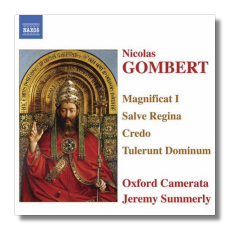
The Internet's Premier Classical Music Source
Related Links
- Gombert Reviews
- Latest Reviews
- More Reviews
-
By Composer
-
Collections
DVD & Blu-ray
Books
Concert Reviews
Articles/Interviews
Software
Audio
Search Amazon
Recommended Links
Site News
 CD Review
CD Review
Nicolas Gombert

- Tulerunt Dominum meum
- Magnificat primi toni
- Credo in unum Deum
- Super flumina Babylonis
- Media vita in morte sumus
- Salve regina (plainchant mode 1)
- Salve regina (diversi diversa orant)
- Epitaphium (in Josquinum a Prato)
Oxford Camerata/Jeremy Summerly
Naxos 8.557732 DDD 62:19
With the release of the Hilliard Ensemble's Nicolas Gombert disc last month (ECM New Series 1884), it looks like we might be in the middle of a renaissance of interest in this composer. We don't know much about him as a person. We do know that he was born circa 1495, probably in the southern portion of Flanders, and that he is likely to have been a pupil of the great Josquin. Gombert served in the chapel choir of Charles V in Spain, and supervised the boys' choir. Unfortunately, he molested one of his charges, was stripped of his position, and sent to the galleys – which in those days was tantamount to a sentence of (slow) death. However, even during his sentence it appears that he continued composing, and he was pardoned by Charles V. Eventually he became canon at the Cathedral of Tournai, and died circa 1560.
Gombert's music is characterized by its density of texture. As I said in my review of the Hilliard disc, "There's not much "air" in Gombert's music; it never lets up." The Hilliard and Oxford Camerata discs contain only two selections in common (the motet Media vita in morte sumus and the Epitaphium, which also is known by its opening words – Musae Jovis). The differences between these two ensembles and their performance styles are obvious and quite important. There are no more than six performers at a time on the Hilliard disc, whereas the Oxford Camerata (here, anyway) contains 16 singers, four to a voice part. This makes Gombert's dense writing sound even denser - imagine a Phil Spector-like "wall of sound," Renaissance style! The Hilliards are all male, with one countertenor. The Oxford Camerata is equally divided between men and women. Gombert's choirs almost certainly would have included boys, not women. Arguably, the Hilliards's David James sounds more "boyish" than the women of the Oxford Camerata, but I am not sure that this really matters. Much as I enjoy the sound of a boys' chorus from time to time, grown women can control their voices far better, and in music as polyphonic as this, that is an asset.
The Hilliards's sound is rarefied and extremely clean. On the other hand, the Oxford Camerata, while less clean, is more emotionally communicative. Listen to their singing of the word "resurrectionem" in the Credo, and the forwardness and immediacy of their style will become immediately obvious. Another potential advantage of the Naxos disc is that the booklet contains not just texts, but – mirabile dictu! – English translations. The ECM disc omits the English translations. The engineering is fine, although not as spectacular as on ECM, where the atmospheric Propstei St. Gerold in Austria almost deserves to be credited alongside the men of the Hilliard Ensemble.
Copyright © 2006, Raymond Tuttle




















